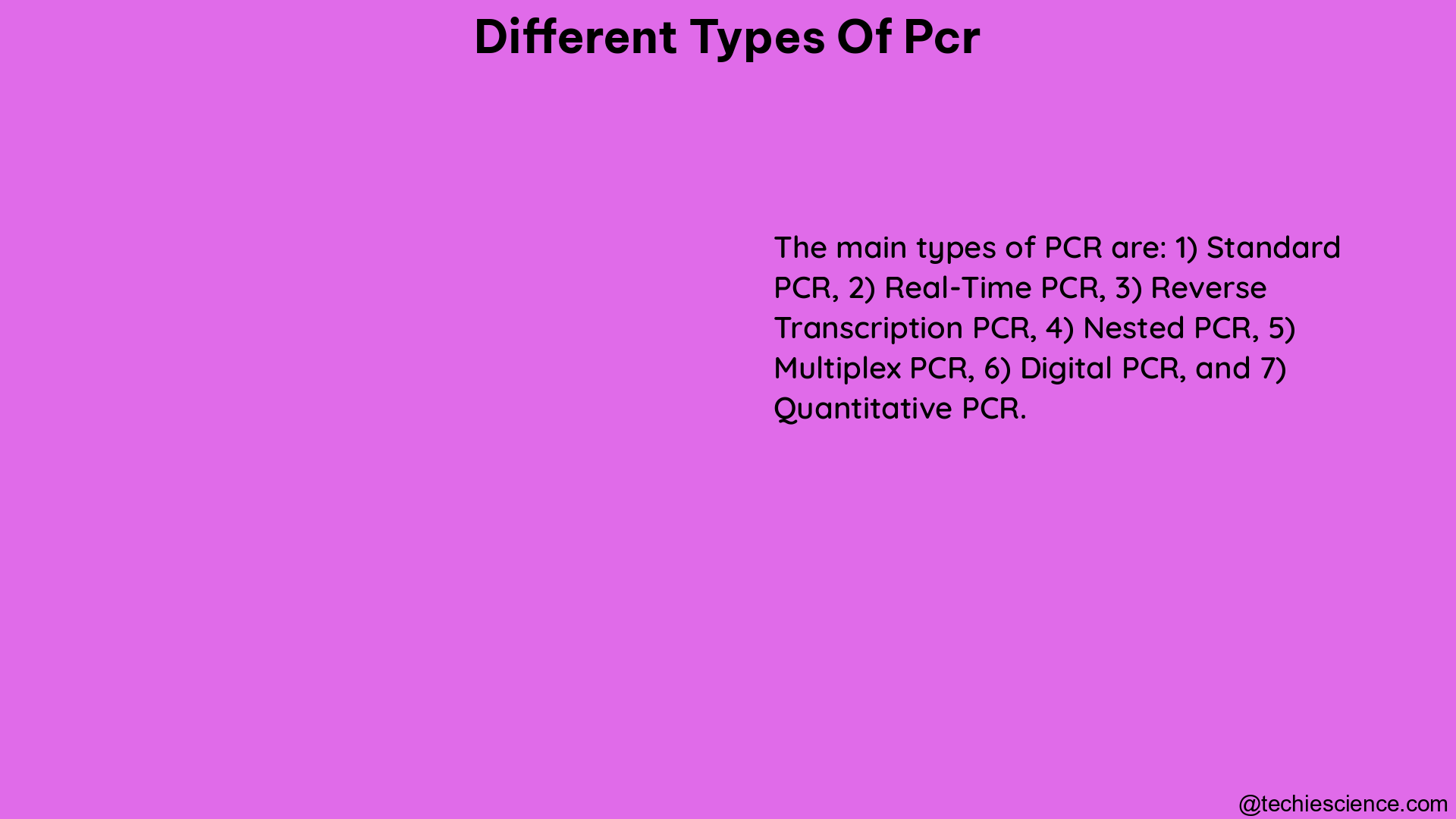Polymerase Chain Reaction (PCR) is a powerful molecular biology technique that has revolutionized the field of genetics, genomics, and molecular diagnostics. This versatile method allows for the rapid and exponential amplification of specific DNA or RNA sequences, enabling researchers and clinicians to detect, quantify, and analyze genetic material with unprecedented precision. In this comprehensive guide, we will delve into the three main types of PCR: end-point PCR, quantitative PCR (qPCR), and digital PCR (dPCR), exploring their unique features, applications, and the factors to consider when choosing the appropriate technique for your research or diagnostic needs.
End-Point PCR: The Foundational Approach
End-point PCR is the most basic and widely used form of PCR, providing a qualitative or semi-quantitative assessment of the presence or absence of a target DNA sequence. This technique measures the final amount of PCR product at the end of the amplification process, typically after a predetermined number of cycles. End-point PCR is a valuable tool for various applications, including:
- Cloning and Sequencing: End-point PCR is commonly used to amplify specific DNA fragments for cloning and subsequent sequencing, enabling the identification and characterization of genes or genomic regions of interest.
- Genotyping and Mutation Detection: End-point PCR can be used to detect the presence or absence of specific genetic variants, such as single nucleotide polymorphisms (SNPs) or insertions/deletions, which is crucial for genotyping and genetic profiling.
- Colony Screening: End-point PCR is a reliable method for screening bacterial colonies to identify those that have successfully incorporated a desired plasmid or DNA insert, streamlining the process of recombinant DNA construction.
- Pathogen Detection: End-point PCR is widely used in diagnostic settings to detect the presence of specific pathogens, such as viruses, bacteria, or fungi, in clinical samples.
While end-point PCR is a simple and cost-effective technique, it is limited in its ability to provide accurate quantification of the target DNA without the use of standard curves. This limitation is addressed by the more advanced techniques of quantitative PCR and digital PCR.
Quantitative PCR (qPCR): Real-Time Monitoring and Precise Quantification

Quantitative PCR, also known as real-time PCR, is a powerful technique that enables the real-time monitoring and quantification of DNA amplification. Unlike end-point PCR, qPCR measures the accumulation of PCR products during the exponential phase of the reaction, providing quantitative data based on the number of amplification cycles and standard curves.
The key features and applications of qPCR include:
- Gene Expression Analysis: qPCR is the gold standard for quantifying gene expression levels, allowing researchers to measure changes in mRNA abundance under different experimental conditions or in response to various stimuli.
- Copy Number Variation (CNV) Analysis: qPCR is widely used to detect and quantify changes in the copy number of specific genes or genomic regions, which can be associated with genetic disorders, cancer, and other diseases.
- SNP Genotyping: qPCR-based assays, such as TaqMan or SYBR Green-based methods, can be used to accurately genotype single nucleotide polymorphisms (SNPs), facilitating genetic association studies and personalized medicine applications.
- Microarray Validation: qPCR is often employed to validate the results obtained from high-throughput microarray experiments, providing a more sensitive and accurate method for gene expression profiling.
- Pathogen Detection and Quantification: qPCR is a valuable tool for the sensitive and specific detection and quantification of viral, bacterial, or fungal pathogens in clinical, environmental, or food samples.
- Environmental Monitoring: qPCR is used to quantify the abundance of specific microbial species or genes in environmental samples, such as soil, water, or air, enabling researchers to study microbial communities and their dynamics.
The key advantage of qPCR over end-point PCR is its ability to provide accurate quantification of the target DNA or RNA, which is essential for many applications in molecular biology, genetics, and diagnostics.
Digital PCR (dPCR): Absolute Quantification without the Need for Standards
Digital PCR (dPCR) is a more recent advancement in the field of PCR, offering a unique approach to the absolute quantification of nucleic acids. Unlike qPCR, which relies on standard curves for quantification, dPCR uses statistical methods to directly determine the absolute number of target molecules in a sample, without the need for reference materials or standard curves.
The key features and applications of dPCR include:
- Rare Variant Detection: dPCR excels at the detection and quantification of low-abundance targets, such as rare genetic variants, DNA methylation patterns, and alternatively spliced mRNA isoforms, making it a valuable tool for cancer research, prenatal diagnostics, and liquid biopsy applications.
- Copy Number Variation (CNV) Analysis: dPCR provides a highly sensitive and accurate method for the quantification of copy number variations, which can be associated with genetic disorders, cancer, and other diseases.
- Viral and Bacterial Load Quantification: dPCR is widely used in the quantification of viral and bacterial loads in clinical samples, enabling more precise monitoring of disease progression and treatment response.
- Next-Generation Sequencing (NGS) Library Quantification: dPCR is an ideal technique for the absolute quantification of NGS libraries, ensuring accurate normalization and optimal sequencing performance.
- Liquid Biopsy and Circulating Nucleic Acid Analysis: dPCR is a powerful tool for the detection and quantification of cell-free DNA (cfDNA), circulating tumor DNA (ctDNA), and other circulating nucleic acids, which are crucial for non-invasive cancer diagnostics and monitoring.
- Environmental and Food Safety Monitoring: dPCR can be used to quantify the presence of specific microbial species or genetic markers in environmental samples, such as water, soil, or food, enabling more accurate monitoring and risk assessment.
The key advantage of dPCR over qPCR is its ability to provide absolute quantification of target molecules without the need for standard curves or reference materials, making it a more robust and reliable technique for applications where precise quantification is critical.
Choosing the Right PCR Technique for Your Needs
When selecting the appropriate PCR technique for your research or diagnostic needs, it is essential to consider the specific requirements of your project, the desired level of quantification, and the available resources. Here are some factors to consider:
- Quantification Requirements: If you need to determine the presence or absence of a target, end-point PCR may be the most suitable choice. If you require accurate quantification of the target, qPCR or dPCR would be the better options, with dPCR offering the highest level of precision and accuracy.
- Sample Complexity and Sensitivity: For samples with low-abundance targets or complex backgrounds, such as liquid biopsy or environmental samples, dPCR may be the preferred technique due to its superior sensitivity and ability to detect rare variants.
- Availability of Standard Materials: qPCR requires the use of standard curves and reference materials for quantification, which may not always be readily available or feasible to obtain. In such cases, dPCR can be a more suitable alternative.
- Instrumentation and Cost Considerations: End-point PCR is generally the most cost-effective and accessible technique, requiring relatively simple and affordable equipment. qPCR and dPCR, on the other hand, require more specialized and expensive instrumentation, which may be a limiting factor for some laboratories or research groups.
- Experimental Design and Data Analysis: The choice of PCR technique may also depend on the complexity of your experimental design and the level of data analysis required. End-point PCR typically involves simpler data analysis, while qPCR and dPCR require more sophisticated data processing and interpretation.
By understanding the unique features, advantages, and limitations of end-point PCR, qPCR, and dPCR, you can make an informed decision on the most appropriate technique for your specific research or diagnostic needs, ensuring accurate and reliable results.
Conclusion
Polymerase Chain Reaction (PCR) is a versatile and indispensable tool in the field of molecular biology, genetics, and diagnostics. The three main types of PCR – end-point PCR, quantitative PCR (qPCR), and digital PCR (dPCR) – each offer distinct advantages and cater to different research and diagnostic requirements. By understanding the unique features and applications of these PCR techniques, researchers and clinicians can select the most suitable method to address their specific needs, whether it’s qualitative detection, precise quantification, or the detection of rare genetic variants. This comprehensive guide has provided a detailed overview of the different types of PCR, equipping you with the knowledge to make informed decisions and leverage the power of these transformative molecular tools in your work.
References:
- Real-Time Polymerase Chain Reaction – ScienceDirect.com
- Absolute vs. Relative Quantification for qPCR – US
- DIFFERENT TYPES OF PCR TECHNIQUES AND ITS APPLICATIONS
- PCR/qPCR Data Analysis – Sigma-Aldrich
- dPCR vs qPCR vs end-point PCR – QIAGEN

I am Abdullah Arsalan , Completed my PhD in Biotechnology. I have 7 years of research experience. I have published 6 papers so far in the journals of international repute with an average impact factor of 4.5 and few more are in consideration. I have presented research papers in various national and international conferences. My subject area of interest is biotechnology and biochemistry with special emphasis on Protein chemistry, enzymology, immunology, biophysical techniques and molecular biology.